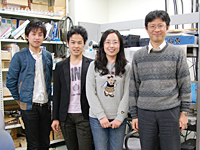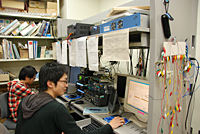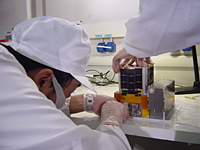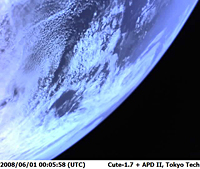What do space satellites and soda cans have in common? The short answer is proof of concept—at least when it comes to the smallest category of satellites loosely dubbed nanosatellites. While the concept of creating a tiny satellite to conduct a limited number of experiments arose in the United States, it was students working in Tokyo Tech's Laboratory for Space Systems (LSS) under the guidance of Associate Professor Saburo Matunaga, who put the concept to the test and built the first demonstration prototype small enough to fit into a can of soda.
“Critics called it a toy,” says Matunaga. “In a sense it was. But it was a toy that demonstrated the concept's potential and showed it could work.”
And it certainly has worked. To date LSS has launched three nanosatellites and is developing a fourth, while labs from around the world have followed with their own launches. The first satellite from LSS was the CUTE-I launched in June 2003 using a Russian rocket. It weighed just 1 kg and its sides measured a mere 10 cm. “This was a student-led project and the first cube-shaped nanosatellite in the world,” says Matunaga. “It is still transmitting its house-keeping data such as temperature measurements back to us today.”
By the time of the third satellite launch—the CUTE-1.7 + APD II in April 2008—the weight had increased to 3.6 kg with dimensions of 10 x 15 x 20 cm. This satellite continues to transmit mission data back to Earth. It is equipped with a CCD still and video camera, which, given the satellite's low orbit of around 600 km, is able to send back useful image data of the earth and cloud formations. More importantly, APD (avalanche photodiode) sensors on board are used to measure low energy particles—the first time this has been achieved at this altitude. The satellite also provides both uplink and downlink services for the use of amateur radio enthusiasts.
“Normally, the cost of developing a satellite is very high, the time taken is very long and you need the help of people from many fields,” says Matunaga. “By focusing on nanosatellites that can perform a small number of missions, we have opened up a new paradigm in space system development. Now, many groups around the world can get access to space through these satellites, and we have had a lot of enquiries from around Japan, the rest of Asia, the US and Europe.”
An interesting case in point comes from China. Chinese post-doctoral researcher Meng Tao from Zhejiang University is currently working in the LSS laboratory and says her university was able to launch its own nanosatellite based on the pioneering work of the Tokyo Tech group.
However, even nanosatellites are not cheap to build. The materials cost alone for CUTE-1.7 + APD II came to 10 million yen. Operating the satellite and processing the mission data can also be expensive and demanding over the long term. LSS project leader Kyohei Akiyama and group leader Junichi Nishida, both masters students, say LSS group members monitor the two satellites from Mondays through Fridays and during university holidays.
“We are now developing new, more efficient methods to produce the next satellite, and also new ways to operate it,” says Matunaga. “We’ve developed a network of ground control stations in Japan. ESA, the European Space Agency, is so interested in our model that it is going to build a network of these stations worldwide. This will help share costs.”
With the launch of the fourth satellite—the 40 kg ‘Tsubame’—planned for 2012, LSS will have a real-time earth monitoring system that could play an important role in warning of extreme weather conditions. Later, a second mission will be able to detect gamma-ray bursts, the brightest electromagnetic events in the universe.
To further promote nanosatellite technology, Matunaga has helped found and is director of the University Space Engineering Consortium (UNISEC) which is playing a major role in helping Japanese universities and colleges develop nanosatellite projects of their own. Nanosatellite technology may have started off small enough to fit in a soda can, but thanks to Tokyo Tech's LSS, it has developed into a phenomenon of global significance with numerous labs and groups around the world now able to participate in space research.
Short video clip of cloud formation over Canada taken by Cute-1.7 + APD II on August 28, 2008

LSS members (from left to right), Project Leader Kyohei Akiyama, Group Leader Junichi Nishida, Tao Meng, Associate Professor and LSS Director Saburo Matunaga.

Students operating an LSS ground control station at Tokyo Tech for monitoring nanosatellites.
. Any information published on this site will be valid in relation to Science Tokyo.






